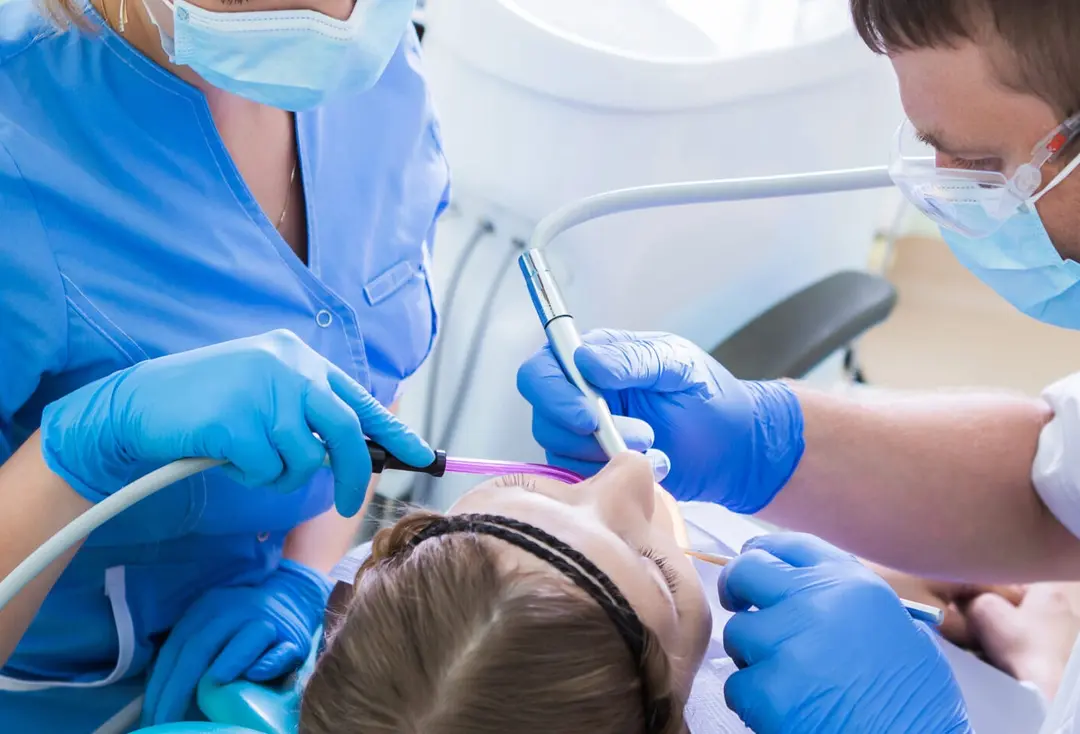Dental operations are dynamic health care environments that necessitate precision, focus, and repetitive movement of the body, in most instances within time limits. While the risk of infection is perhaps the most generally accepted, there is an array of ergonomic, chemical, physical, and psychosocial hazards in the dental operating environment. Hazard recognition and proactive control are required to avoid injury and harm to patients and dental professionals.
In this article, we’ll explore the key hazards in a dental practice, with expert insights on modes of exposure and evidence-based control measures.
Major Hazards in a Dental Practice
1. Musculoskeletal Disorders (MSDs)
Repetitive movements, awkward postures, static positions, and forceful exertions are part of a dental professional’s daily routine. These contribute to chronic neck, shoulder, back, and wrist pain, often culminating in long-term musculoskeletal disorders.
Mode of Exposure:
-
Prolonged static postures (e.g., leaning over patients)
-
Poor workstation setup (e.g., non-adjustable chairs, improper lighting)
-
Repetitive fine motor tasks (e.g., scaling, drilling)
Management:
-
Introduce ergonomic dental chairs and stools with lumbar support.
-
Implement “four-handed dentistry” to reduce overreach and twisting.
-
Train staff in posture correction and regular stretching techniques.
-
Rotate tasks and include micro-breaks during procedures.
2. Needlestick and Sharps Injuries
Dental professionals frequently handle needles, scalpels, and other sharp instruments, increasing the risk of accidental punctures that can transmit bloodborne pathogens such as Hepatitis B, Hepatitis C, and HIV.
Mode of Exposure:
-
Improper disposal of sharps
-
Recapping of needles
-
Accidental slips during procedures or cleanup
Management:
-
Use needle safety devices and avoid recapping needles.
-
Adopt a “no-hands” passing technique.
-
Install puncture-resistant sharps containers at the point of use.
-
Provide regular training on sharps safety and post-exposure protocols.
Read Also: Public Safety and Health: Major Areas and Career Path
3. Chemical Hazards
Dental materials such as disinfectants, resins, adhesives, and amalgam contain hazardous substances. Prolonged exposure can cause respiratory irritation, skin sensitization, or even long-term systemic effects.
Mode of Exposure:
-
Inhalation of volatile organic compounds (VOCs)
-
Skin contact with allergens or corrosive chemicals
-
Inadequate ventilation systems
Management:
-
Substitute high-risk chemicals with safer alternatives when possible.
-
Use local exhaust ventilation and ensure adequate room ventilation.
-
Provide PPE such as gloves, goggles, and chemical-resistant aprons.
-
Store chemicals according to COSHH (Control of Substances Hazardous to Health) regulations and ensure proper labelling.
4. Biological Hazards (Infectious Agents)
Close patient contact and aerosol-generating procedures expose dental teams to infectious agents, including bacteria, viruses, and fungi.
Mode of Exposure:
-
Contact with blood and saliva
-
Inhalation of airborne pathogens
-
Contaminated surfaces and equipment
Management:
-
Adhere strictly to infection prevention protocols.
-
Use high-volume suction and rubber dams to minimize aerosol spread.
-
Disinfect all surfaces between patients and sterilize instruments.
-
Ensure vaccination (e.g., Hepatitis B) and regular health screening for staff.
5. Radiation Exposure
Dental radiography involves ionizing radiation, which, if improperly handled, can cause tissue damage or increase cancer risk over time.
Mode of Exposure:
-
Accidental exposure during X-ray procedures
-
Improper shielding or faulty radiographic equipment
Management:
-
Use lead aprons and thyroid collars for patients.
-
Ensure operators stand behind protective barriers or use remote activation.
-
Regularly calibrate and maintain radiographic equipment.
-
Train staff in safe radiographic techniques and ALARA principles (As Low As Reasonably Achievable).
6. Psychosocial Hazards
High patient loads, emotional demands, and time pressures can contribute to occupational stress, burnout, and mental health issues.
Mode of Exposure:
-
Excessive workload or long hours
-
Patient anxiety and conflict situations
-
Lack of autonomy or support from management
Management:
-
Encourage open communication and stress management workshops.
-
Allow regular rest breaks and rotate duties to reduce fatigue.
-
Foster a supportive work culture with peer mentoring.
-
Implement an employee assistance program (EAP).
Read Also: How Does Social Practice Affect Hygiene?
7. Slips, Trips, and Falls
Wet floors, trailing cords, and cluttered pathways are common causes of slips and trips in dental settings.
Mode of Exposure:
-
Spilled liquids near sinks or operatories
-
Unsecured electrical cords
-
Obstructed walkways
Management:
-
Use slip-resistant flooring and immediate spill cleanup protocols.
-
Route cords safely and install cable covers.
-
Conduct regular housekeeping checks.
-
Provide anti-slip footwear for staff.
Final Thoughts: Building a Culture of Safety in Dentistry
Effective safety in dental practice starts with risk awareness and a commitment to proactive ergonomics and safety protocols. By addressing both physical and psychosocial hazards, dental clinics can protect their workforce from injury and improve overall care delivery.
Key Takeaways:
-
Regular ergonomic assessments are critical.
-
Safety protocols must be reviewed and updated periodically.
-
Staff training should be continuous, covering both clinical and environmental risks.
-
A safe practice is a productive practice, benefiting both staff and patients.
A seasoned Health and Safety Consultant with over a decade of hands-on experience in Occupational Health and Safety, UBONG EDET brings unmatched expertise in health and safety management, hazard prevention, emergency response planning, and workplace risk control. With a strong passion for training and coaching, he has empowered professionals and organizations to build safer, more compliant work environments.
Certified in globally recognized programs including NEBOSH, ISO standards, and OSHA regulations, he combines technical know-how with practical strategies to drive health and safety excellence across industries. designing comprehensive HSE management systems or delivering impactful safety training, whether he] is committed to promoting a culture of safety and continuous improvement.
